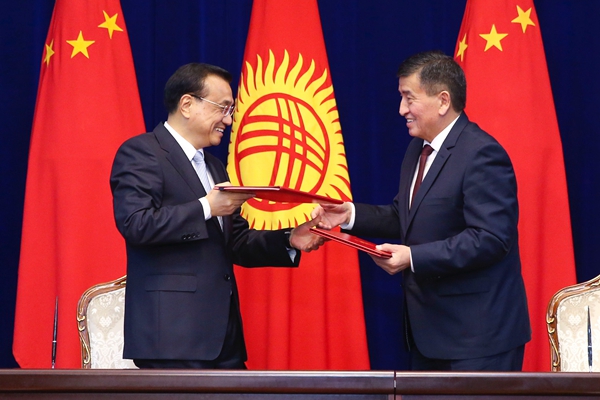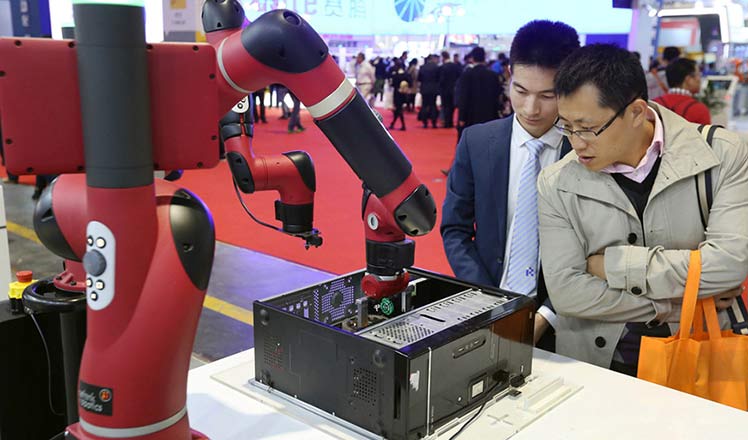Li's trip to secure gains, reinforce bonds
Updated: 2016-11-03 08:34
By Wang Yiwei(China Daily)
|
||||||||
 |
|
Premier Li Keqiang and Kyrgyz Prime Minister Sooronbay Jeenbekov signed on Nov 2 a joint communiqué between the Chinese and Kyrgyz governments.[Photo/english.gov.cn] |
Premier Li Keqiang embarked on an eight-day trip to Central Asia and Europe on Wednesday, during which he will visit Kyrgyzstan, Kazakhstan, Latvia and Russia. His participation in the 5th Meeting of the Heads of Government of China and Central and Eastern European (CEE) countries in Riga, Latvia, is expected to add fresh momentum to the "16+1" cooperative mechanism and the Belt and Road Initiative (the Silk Road Economic Belt and 21st Century Maritime Silk Road).
The 16+1 mechanism proposed by Beijing is an exchange program involving 1,000 people from China and 16 CEE countries to enhance people-to-people communications.
Since the first 16+1 meeting in Warsaw in 2012 the multinational mechanism has become an example of China-Europe cooperation and is having a greater positive effect on regional cooperation. It is expected to synergize with the Belt and Road projects, too, by boosting trade and investment exchanges.
CEE countries account for about a quarter of all "roadside" countries and play a key role in the world's emerging market, which allows them to cooperate with China on a highly complementary basis, especially when it comes to connectivity, capacity cooperation and cross-border trade.
The Hungary-Serbia railway, scheduled for completion by the end of 2017, will extend to the important Greek port of Piraeus and could become a European pivot connecting the Silk Road Economic Belt and 21st Century Maritime Silk Road.
The efficient capacity cooperation between China and Serbia in recent years is another case in point. Since it established a strategic partnership with China in 2009, the Balkan state has accommodated an increasing number of infrastructure projects sponsored by China, including the Pupin Bridge over the Danube River in Belgrade and the Kostolac power plant, the first Chinese electric power project in Europe.
On the trade and investment front, cross-border e-commerce has great potential to take the 16+1 cooperation to a new height. City-to-city collaboration, too, has begun to bear fruit. Chengdu in Southwest China's Sichuan province is now a sister city to Poland's Lodz and home to a consulate general of Poland.
The China-EU 2020 Strategic Agenda for Cooperation, adopted at the 2013 China-EU summit, has endorsed the 16+1 mechanism and enhanced its status as a new platform for European integration, which should silence people accusing Beijing of using a "divide-and-rule" strategy toward Europe.
New financing platforms, such as a China-CEE investment bank under deliberation, will promote the financial integration not just between the two parties, but also within Europe. In fact, the European Union has come to realize the importance of the 16+1 mechanism as a supplement to the China-Europe relationship. That explains why the EU is now an observer at the Meeting of Heads of Government of China and Central and Eastern European Countries.
CEE countries are relatively eager for Beijing's technological and financial support compared with other EU members, opening a rare window of opportunity for China-Europe cooperation. So, under the framework of the 16+1 mechanism, China has every reason to deepen its partnership with Europe and expedite the Belt and Road's expansion.
The author is a professor of international relations at Renmin University of China.
- France to begin moving migrant minors from Calais
- China-Japan ties growing but unstable: Premier
- Analysts to watch Alibaba's cloud computing, mobile results
- UN Security Council hails election of new president in Lebanon
- Regular China-South Asia freight train launched
- Police swoop on Paris migrant camp after Calais Jungle clearout

 Robots draw people to China International Industry Fair
Robots draw people to China International Industry Fair
 German international Miroslav Klose retires
German international Miroslav Klose retires
 Top 10 most influential Japanese cartoons in China
Top 10 most influential Japanese cartoons in China
 Opera performer who takes her shows to villages
Opera performer who takes her shows to villages
 13 most appealing cars in China in 2016
13 most appealing cars in China in 2016
 Obamas host White House Halloween for children
Obamas host White House Halloween for children
 China Fashion Week: Liu Yong Exclusive
China Fashion Week: Liu Yong Exclusive
 Top 5 collaborating countries in Belt and Road Initiatives
Top 5 collaborating countries in Belt and Road Initiatives
Most Viewed
Editor's Picks

|

|

|

|

|

|
Today's Top News
US election rhetoric unlikely to foreshadow future US-China relations
'Zero Hunger Run' held in Rome
Trump outlines anti-terror plan, proposing extreme vetting for immigrants
Phelps puts spotlight on cupping
US launches airstrikes against IS targets in Libya's Sirte
Ministry slams US-Korean THAAD deployment
Two police officers shot at protest in Dallas
Abe's blame game reveals his policies failing to get results
US Weekly

|

|








